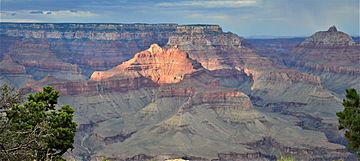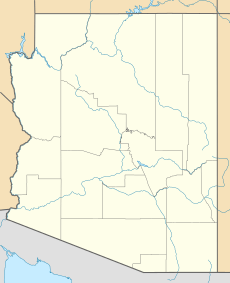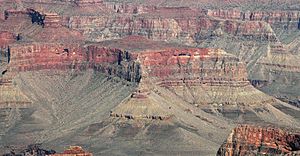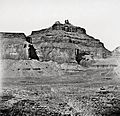Angels Gate facts for kids
Quick facts for kids Angels Gate |
|
|---|---|

Angels Gate illuminated, from Shoshone Point
|
|
| Highest point | |
| Elevation | 6,761 ft (2,061 m) |
| Prominence | 1,361 ft (415 m) |
| Isolation | 1.81 mi (2.91 km) |
| Parent peak | Wotans Throne (7,721 ft) |
| Geography | |
| Location | Grand Canyon National Park Coconino County, Arizona, US |
| Parent range | Kaibab Plateau Colorado Plateau |
| Topo map | USGS Cape Royal |
| Type of rock | sandstone, siltstone, mudstone |
| Climbing | |
| First ascent | April 1972 |
| Easiest route | class 5.8 climbing |
Angels Gate is a really tall mountain peak in the amazing Grand Canyon! It stands about 6,761 feet (2,061 meters) high. You can find it in Coconino County, Arizona, in the southwestern USA. It's about 7 miles north of Grandview Point, a popular spot on the canyon's South Rim.
This mountain is super impressive because it rises over 4,200 feet from the Colorado River below in just three miles! In Paiute mythology, Angels Gate was a special place where the gods would come down to Earth from the shadow world above. George Wharton James first called this place "Angel Gate" in his 1900 book, In & Around the Grand Canyon. The name was officially accepted in 1906 by the U.S. Board on Geographic Names.
Angels Gate has four peaks made of a rock called Coconino Sandstone. The main, highest peak and three spires look a bit like Snoopy and his doghouse, so they are sometimes called "Snoopy and his Doghouse." The very first time someone climbed to the top was in April 1972, by Chuck Graf and Dave Ganci. Angels Gate is in a cold semi-arid climate zone, which means it's usually dry and can get quite cold.
How Angels Gate Was Formed (Geology)
The top part of Angels Gate is made of a type of rock called Permian Coconino Sandstone. This sandstone is one of the youngest rock layers in the Grand Canyon. It was formed about 265 million years ago from ancient sand dunes.
Below the Coconino Sandstone, you'll find the Permian Hermit Formation. Underneath that is the Pennsylvanian-Permian Supai Group. Even further down are layers of Mississippian Redwall Limestone, Cambrian Tonto Group, and finally, the very old Proterozoic Unkar Group near the river. When it rains, water flows off Angels Gate and drains south into the Colorado River.
Hawkins Butte
Hawkins Butte is a smaller mountain, or butte, that is connected to the southwest side of Angels Gate. It stands about 5,340 feet (1,628 meters) high. This butte was officially named in 1932 after William "Billy" Robert Hawkins. He was a hunter and cook for John Wesley Powell's famous 1869 trip down the Colorado River through the Grand Canyon. Hawkins Butte is mostly made of Redwall Limestone on top of the Tonto Group rock layers.
Gallery
Images for kids













